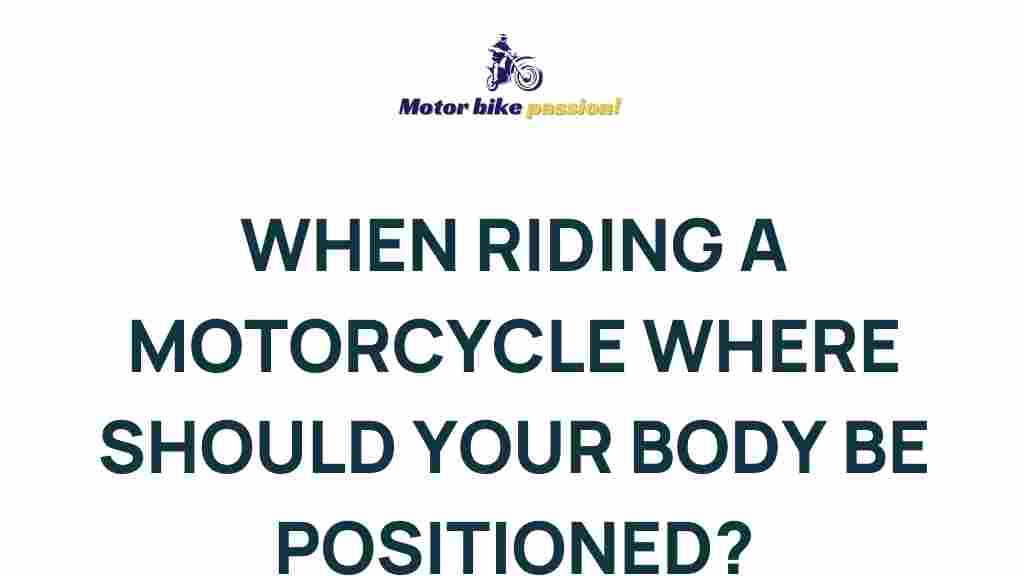Unleash the Power: Mastering Motorcycle Body Positioning
Motorcycling is more than just a mode of transportation; it’s an exhilarating experience that offers freedom and excitement. However, to truly enjoy and master this experience, understanding motorcycle body positioning is vital. Proper body positioning not only enhances your riding technique but also significantly improves cornering and control. This article dives deep into the essentials of motorcycle body positioning, offering tips and techniques that can transform your riding experience.
Understanding Motorcycle Body Positioning
Body positioning on a motorcycle refers to how a rider positions their body in relation to the motorcycle and the road. This positioning is crucial for several reasons:
- Stability: Proper body positioning helps maintain balance and stability while riding.
- Control: It allows for better control of the motorcycle, especially during cornering.
- Comfort: Correct positioning reduces fatigue during long rides.
- Safety: It enhances overall safety by allowing for quicker reactions to obstacles.
Key Elements of Motorcycle Body Positioning
To master motorcycle body positioning, there are several key elements to consider:
- Feet Placement: Keeping your feet on the pegs and positioned correctly is essential for control.
- Knees: Your knees should grip the tank to maintain stability, especially in turns.
- Upper Body: Leaning your upper body into the turn can significantly improve cornering.
- Head Position: Looking through the turn helps in anticipating the road ahead.
Step-by-Step Guide to Mastering Body Positioning
1. Starting Position
Before you even start the motorcycle, ensure your initial body position is correct:
- Stand over the bike with your feet flat on the ground.
- Ensure your body is relaxed, and your hands are lightly gripping the handlebars.
2. Feet on the Pegs
Once you’re on the move, place your feet firmly on the pegs. Here’s how to do it:
- Keep your toes pointed slightly inward to prevent dragging.
- Maintain a slight bend in your knees to absorb shocks from the road.
3. Knees Against the Tank
For better control, your knees should grip the fuel tank:
- Press your knees against the tank while keeping your feet on the pegs.
- This helps in stabilizing your body during turns.
4. Leaning into the Turn
When approaching a corner, lean your upper body into the turn:
- Shift your weight towards the inside of the corner.
- Keep your hips low and close to the bike.
5. Head Positioning
Looking through the turn is critical:
- Turn your head to look where you want to go, not at the ground.
- This helps in setting your line and maintaining control.
6. Practice, Practice, Practice
Like any skill, mastering body positioning requires practice. Here are some tips:
- Find a safe, open area to practice your body positioning.
- Gradually increase your speed as you become more comfortable.
Common Mistakes in Motorcycle Body Positioning
Even experienced riders can make mistakes in body positioning. Here are some common pitfalls:
- Too Rigid: Riding with a stiff body can hinder control and balance.
- Incorrect Head Position: Looking down instead of through the turn can lead to poor line choices.
- Feet Dragging: Allowing your feet to drag can affect stability and reaction time.
Troubleshooting Body Positioning Issues
If you’re experiencing difficulties with body positioning, consider the following tips:
- Review Your Technique: Go back through the steps outlined above and ensure you’re following the correct posture.
- Seek Feedback: Riding with a friend or instructor can provide valuable feedback on your body positioning.
- Record Yourself: If possible, have someone film you while riding to identify areas for improvement.
Additional Riding Techniques to Enhance Control
In addition to body positioning, there are other riding techniques that can enhance your control:
- Throttle Control: Smooth throttle application is crucial for maintaining balance and acceleration.
- Braking Technique: Use both front and rear brakes effectively to maintain control during slowing down or stopping.
- Look Ahead: Always keep your eyes focused on where you want to go, not where you are.
For more in-depth riding techniques, check out this comprehensive motorcycle riding guide.
Conclusion
Mastering motorcycle body positioning is essential for every rider looking to enhance their riding experience. Proper body positioning not only improves cornering and control but also contributes to overall safety and enjoyment on the road. By practicing the techniques outlined in this article and being mindful of common mistakes, you can unleash the full power of your motorcycle. Remember, the journey of mastering body positioning is ongoing, so keep practicing and refining your skills!
To further enhance your skills, consider joining a local riding group or seeking professional lessons. Riding is a journey of continuous learning, and every experience contributes to your growth as a motorcyclist. Happy riding!
For more information on motorcycle safety and techniques, visit Motorcycle Safety Foundation.
This article is in the category Safe Driving and created by MotorBikePassion Team
